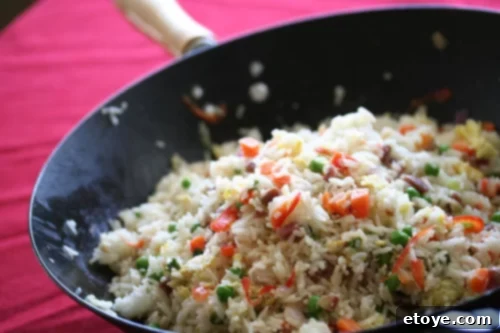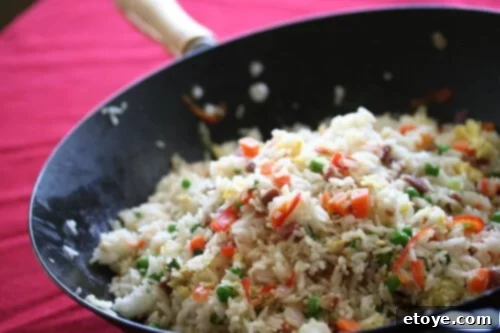Master the Art of Homemade Fried Rice: Unlocking Authentic Flavors and Culinary Secrets
Fried rice is more than just a quick meal; it’s a globally cherished comfort food, a culinary canvas for endless creativity, and often, the ultimate expression of using up delicious leftovers. While many associate it with Chinese cuisine, its versatility has allowed it to become a staple across Asia and beyond. Forget the notion of soggy, clumpy, or bland fried rice. This guide delves into the essential secrets that transform a simple dish into an extraordinary culinary experience, rivaling your favorite takeout. We’ll explore the foundational elements and advanced techniques that ensure every grain is perfectly seasoned, every ingredient shines, and every bite is a burst of umami.
At its heart, fried rice is a testament to resourceful cooking, a brilliant way to transform refrigerator scraps into something spectacular. The beauty lies in its adaptability; the vegetables and meats can vary wildly depending on what you have on hand, making each batch a unique creation. However, amidst this flexibility, there are three non-negotiable constants that form the backbone of truly exceptional fried rice:
- The Right Rice
- Authentic Fish Sauce
- Savory Chinese Sausage (Lap Cheong)
The accompanying image showcases a vibrant medley of ingredients including crisp red bell pepper, tender frozen peas and carrots, fluffy scrambled eggs, sweet red onion, and aromatic Chinese sausage. But don’t let this limit your imagination! Feel free to incorporate your preferred ingredients such as tender bok choy, crunchy broccoli, thinly sliced cabbage, sweet baby corn, succulent pork, plump shrimp, juicy chicken, flavorful ground beef, or delicate scallops. The possibilities are truly endless. While a basic recipe for fried rice is readily available (and we’ll reference it later), this article focuses not on a step-by-step recipe, but on the transformative secrets that elevate your fried rice from good to absolutely phenomenal. Prepare to uncover the wisdom that makes all the difference.

The Foundation of Flavor: Essential Secrets for Unforgettable Fried Rice
Secret #1: The Perfect Rice – Not All Grains Are Created Equal
The single most crucial ingredient in fried rice, surprisingly, isn’t freshly cooked rice. Picture this: a steaming hot batch of rice, straight from the cooker. It’s incredibly moist, plump, and has a slight stickiness. While delightful on its own, these characteristics are the arch-nemeses of perfect fried rice. Attempting to fry such rice would result in a clumpy, soggy, and utterly disappointing mess, where individual grains lose their identity and become a homogeneous mush. This is precisely why day-old rice is the undisputed champion for fried rice applications.
When rice is cooked and then refrigerated overnight, a magical transformation occurs. The grains naturally dry out and firm up. This process, known as retrogradation, reduces the moisture content and makes the individual grains less sticky and more separated. The result? Fried rice that is light, fluffy, and beautifully flaky, allowing each grain to crisp up gently in the wok and truly let the nuanced flavors of your other ingredients shine through. For the absolute best texture and aroma, I almost exclusively use long-grain Jasmine rice. Its fragrant profile and distinct grain structure are ideal for this dish.
But what if you’re craving fried rice and don’t have a batch of day-old rice on hand? Don’t despair! There’s a clever workaround. When cooking fresh rice specifically for fried rice, reduce the amount of water by approximately one-quarter to one-third. This will yield a drier, firmer rice from the outset. Once cooked, immediately spread the hot rice out onto a wide baking sheet or a large platter. This maximises surface area, allowing the steam and excess moisture to quickly escape, and helps the rice cool down rapidly. It’s vital not to attempt frying the rice until it has completely cooled. To expedite this crucial cooling and drying process, you can place the baking sheet in the refrigerator, freezer, or even near an open window. This ensures your rice achieves that ideal dry, separated texture essential for a truly outstanding fried rice.
Secret #2: The Umami Powerhouse – Embracing Fish Sauce
The mention of “fish sauce” often elicits a hesitant “ewww” from many non-Asian palates, and understandably so. Its raw aroma can be quite potent. However, let me assure you, this unassuming condiment is a foundational pillar of flavor in countless cuisines. Think about it: most dishes served in an authentic Thai or Vietnamese restaurant owe a significant part of their complex flavor profile to fish sauce. It functions much like the salt of Southeast Asian cooking, providing a deep, savory foundation that elevates all other ingredients.
For those still skeptical, consider other fermented and pungent ingredients embraced in Western cooking. Do you truly know what Worcestershire Sauce is made of? Anchovy paste, a concentrated form of fermented fish, is a secret weapon in many Italian sauces and stews, providing depth without a distinct fishy taste. The magic of fish sauce is similar: a little goes a very long way, and once it’s cooked into a dish, its unique pungency transforms into a rich, savory depth that is incredibly difficult to pinpoint. I personally swear by the “Three Crabs” brand, which consistently delivers superior quality.

When selecting a good fish sauce, pay close attention to its color. You’re looking for a clear, tea-colored liquid. This hue typically indicates that it’s a first pressing, signifying the highest quality and most delicate flavor. If the fish sauce appears dark, murky, or has a color resembling Coca-Cola, it’s best to avoid it, as this often indicates lower quality or the addition of caramel coloring. Now, to address the elephant in the room: the smell. Let’s not sugarcoat it – raw fish sauce has a distinctive, pungent aroma. Don’t even try to pretend it doesn’t. But here’s the wondrous mystery: despite its initial scent, when incorporated sparingly and cooked into your dish, the final product will bear absolutely no resemblance to that initial aroma. It simply disappears, leaving only a profound savory essence.
On its own, pure fish sauce on the tongue is intensely salty and pungent. However, when it interacts with other flavor notes – the bright acidity of lime, the subtle sweetness of sugar, or the fiery kick of chili – it transports the dish to another dimension. This phenomenon is often described as “umami,” the fifth basic taste, characterized by a savory richness and mouthfeel. I use fish sauce because it masterfully rounds out the overall flavor profile of fried rice, contributing a unique salty-sweet depth that simply cannot be replicated by using plain sugar and salt. I add fish sauce incrementally, typically about 1/2 teaspoon at a time, at the same stage as other liquid seasonings. It’s crucial to taste as you go, ensuring it enhances the dish without becoming overtly salty or overly pungent. Furthermore, utilize vigorous “wok fry” motions to ensure the fish sauce is evenly dispersed throughout the rice. The last thing you want is for a guest to take a bite and be overwhelmed by an undiluted shot of fish sauce!
Secret #3: The Flavor Bomb – Chinese Sausage (Lap Cheong)
If fish sauce is the umami backbone, then Chinese sausage, or Lap Cheong, is the flavor bomb that adds a distinct layer of savory richness and a hint of sweetness. Think of it as the Asian cousin to Italian pancetta; its magic lies in rendering its fat. This fat is precisely where the majority of its incredible flavor is hidden, a concentrated essence that also contributes its own unique “umami” notes to the dish. These preserved sausages boast an impressive shelf life, often lasting for an extended period in the refrigerator, making them a convenient and reliable pantry staple.
The preparation is simple yet crucial. Begin by dicing the Chinese sausage into small, uniform 1/4-inch pieces. Place these diced pieces into a warm wok or sauté pan over low heat. The key here is patience; resist the urge to crank up the heat. Allow the sausage to gently cook and render its fat over a few minutes, undisturbed. You’ll be generously rewarded with a pool of rich, golden, and incredibly flavorful fat oozing out from the sausage. This rendered fat is liquid gold, and it will serve as the primary cooking medium for the rest of your fried rice ingredients, completely replacing the need for any additional cooking oil. This infusion of sausage fat at the very beginning sets a deeply savory base that permeates every component of your fried rice, delivering an unparalleled depth of flavor and aroma.

Secret #4: The Fiery Dance – Mastering High Heat Cooking
Once you’ve added your carefully prepared day-old rice to the wok, it’s time to unleash the power of high heat. This is not the time for timid simmering; your wok or sauté pan must be screaming hot. The objective is to ensure that every single grain of rice is subjected to intense, direct heat, heating it through to its very core. This high-heat treatment serves two critical functions that are indispensable for truly spectacular fried rice.
Firstly, the scorching heat masterfully melds all the individual flavors together, creating a harmonious and cohesive dish rather than a collection of disparate ingredients. The rapid cooking at high temperatures fosters a complex interplay of tastes and aromas. Secondly, and equally important, this intense heat is crucial for evaporating any residual moisture. This includes excess moisture still present in the rice itself, as well as any liquids introduced through seasonings like soy sauce or fish sauce. Rapid evaporation prevents the rice from becoming soggy and promotes the development of that desirable slightly crispy, dry texture characteristic of perfectly fried rice. When your fried rice is truly done, you’ll notice the individual grains practically “dancing” and leaping off the wok as you stir-fry, a clear indicator of properly separated, thoroughly heated, and deliciously textured rice. Mastering this high-heat technique is the essence of achieving that coveted “wok hei” – the smoky, complex aroma imparted by a well-seasoned wok over an inferno of heat.
Secret #5: Preserving Perfection – Storing and Reheating Leftover Fried Rice
It’s a rare and delightful occasion to have leftover fried rice, but when you do, knowing how to properly store and reheat it is key to enjoying it just as much the next day. To keep your fried rice at its best, store any leftovers tightly covered in an airtight container in the refrigerator. The beauty of day-old rice actually continues to work in your favor here; the rice will dry out further in the refrigerator, which paradoxically contributes to an even better texture upon reheating. And rest assured, with the right reheating method, it will taste just as delicious, if not more so, the following day.
The secret to perfectly reheated fried rice lies in mimicking the steaming process. Most people fall into the trap of simply microwaving cold fried rice, which often results in dry, hard, and unappealing clumps. Instead, embrace this simple yet ingenious trick: lightly wet your hands and gently “flick” or “splash” a very small amount of water (about a teaspoon or less) evenly over the cold fried rice. Do not add too much water; just a light misting is all you need. Then, cover the container tightly (a microwave-safe lid or even a plate works perfectly) and microwave on high heat. The microwave will rapidly heat the small amount of water you added, transforming it into steam. This steam then gently re-steams and rehydrates the rice grains, bringing them back to their original fluffy, tender texture without making them soggy. This method ensures your leftover fried rice remains flavorful, moist, and wonderfully textured, making second helpings just as satisfying as the first.
Beyond the Secrets: Crafting Your Signature Fried Rice
With these five fundamental secrets under your belt, you’re now equipped to create fried rice that rivals any restaurant. The beauty of this dish, as mentioned, lies in its incredible versatility. Feel empowered to experiment with a wide array of ingredients, making each batch uniquely yours. Don’t hesitate to substitute different meats, seafood, or vegetables based on your preferences or what’s available. The general cooking sequence usually involves sautéing your protein, followed by aromatics like garlic and ginger, then your chosen vegetables, a quick scramble of eggs, and finally, introducing the star—your perfectly prepared rice—along with the essential seasonings. Always remember that the quality of your ingredients, combined with these masterful techniques, will lead to the most delicious results. The joy of personalized cooking, especially with a dish as comforting as fried rice, is truly unparalleled.
For a more structured guide on ingredient quantities and a step-by-step process, you can refer to this crab fried rice recipe as a guideline. However, the true essence of making the most delicious fried rice comes from understanding and applying the invaluable secrets shared in this post. So go ahead, unleash your inner chef, and enjoy the journey of creating perfect fried rice!
